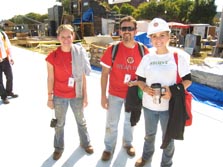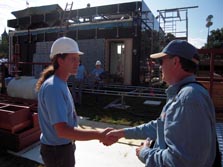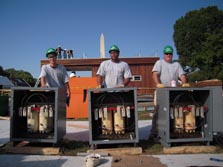
Click photo to view high-resolution image.

Catherine Guidry, Michael Quinones, and Gretchen Lacomb-Vanicor of the University of Louisiana at Lafayette team head to the main tent to grab some breakfast after a night of hard work.
(Credit: Richard King/U.S. Department of Energy Solar Decathlon)

Richard King shakes hands with Geofy Thün, faculty advisor for Team Ontario/BC's North House.
(Credit: Angel Borrego Cubero/U.S. Department of Energy Solar Decathlon)

Employees of John E. Kelly & Sons Electrical Construction stand behind step-up transformers used to increase the voltage of the village microgrid.
(Credit: Angel Borrego Cubero/U.S. Department of Energy Solar Decathlon)
Solar Decathlon 2009
Daily Journal - October 3, 2009
Pepco Net Meters Installed and Grid Connection Preparation Begins
Morning is my favorite time to the stroll the solar village and visit with teams. I caught up with the University of Louisiana at Lafayette crew, which was headed out to grab breakfast provided by Demilec, one of our sponsors. The team has had great support from parents and community members who are here in D.C. supplying sandwiches and running errands for the decathletes.
Walking past the Team Ontario/BC site, I heard a variety of languages. Faculty Advisor Geoff Thün explained that most of the team members hail from the multicultural cities of Vancouver and Toronto. At any given moment, you can hear Italian, Cantonese, Persian, Polish, French, and English on the team's lot.
The news today is that Pepco net meters are being installed in preparation for connecting the village to a temporary microgrid, a small electrical grid on the National Mall. For the first time, the Solar Decathlon will demonstrate how residential solar electric systems operate when connected with the power grid.
Here's how it works. Bidirectional electric utility meters measure the flow of electricity into and out of the houses. When the meter runs forward, electricity is being pulled from the Pepco distribution grid into the house. When it runs backward, excess power generated by the house's solar-electric system is flowing out to the utility grid. This arrangement enables Solar Decathlon teams to supply surplus power from their houses to Pepco's system—and to consume power from Pepco when needed.
A special thanks to Schneider Electric for supplying design, site, and engineering services as well as the electrical distribution equipment required to safely and reliably connect the solar village with Pepco's system. John E. Kelly & Sons Electrical Construction has been on site this past week as well laying cable, setting up transformers, and preparing the houses for grid connection. Along with Pepco, the crews are working overtime to make sure all the houses are ready to be connected with the grid on Monday.
The 2009 Solar Decathlon will feature a new Net Metering contest, which will measure not only the electricity consumed by the house but also the electricity produced by the house's solar electric system. The Net Metering contest is worth up to 150 points. Part of the contest (worth 100 points) requires a house to produce as much electricity as it uses—that is, it must have a zero reading on its net meter at the end of the 10-day competition. In addition, the teams can earn up to 50 bonus points, on a sliding scale, based on surplus electricity produced.
Meanwhile, the teams continue their march to pass house inspections, including building, electrical, plumbing, mechanical, and safety inspections. How quickly a team passes inspections indicates how much progress it has made. Cornell and the University of Louisiana lead the way with the most inspections passed so far.
All the teams I have talked with say they are ahead of schedule compared with previous years. We are all happy things are going so smoothly.
